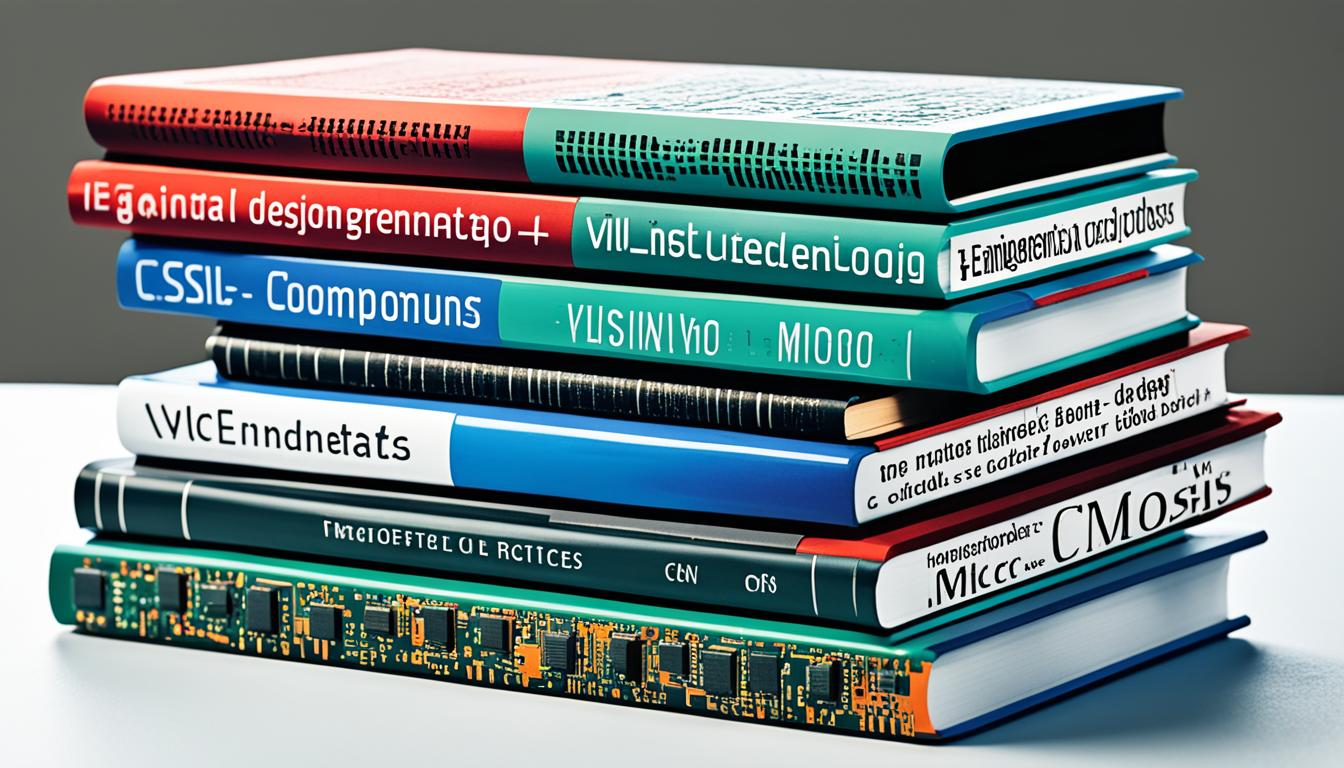In this article, we will present our carefully curated selection of the top 10 books that are essential for every VLSI Engineer in India. These books cover a wide range of topics related to chip design and provide in-depth knowledge and insights that are beneficial for mastering the complexities of VLSI engineering.
As VLSI design continues to evolve and advance, it is crucial for engineers to stay updated with the latest industry trends, techniques, and methodologies. These top 10 books have been chosen based on their relevance and effectiveness in equipping VLSI engineers with the necessary skills and expertise.
Whether you are a beginner looking to enter the field of VLSI design or an experienced professional striving to enhance your knowledge, these books are invaluable resources that will help you excel in your career.
From covering the fundamentals of VLSI design to exploring advanced techniques, from understanding the intricacies of fabrication and manufacturing to mastering Verilog and VHDL programming, these books offer comprehensive and practical guidance for every aspect of VLSI engineering.
We understand the importance of having reliable and up-to-date resources at your disposal, which is why we have carefully selected these top 10 books that cater to the specific needs and challenges faced by VLSI engineers in India.
Join us as we embark on this enlightening journey through the pages of these books, unlocking the secrets of successful VLSI design and taking your skills to new heights.
Table of Contents
Fundamentals of VLSI Design
In this section, we will explore books that cover the fundamentals of VLSI design, providing a comprehensive overview of the concepts and techniques used in chip design. These books serve as essential resources for VLSI engineers looking to solidify their understanding of key principles and methodologies.
From logic design to circuit design and system-level design, these books offer in-depth insights into the various stages of the VLSI design process. Whether you are a beginner seeking to establish a strong foundation in VLSI design or an experienced professional looking to broaden your knowledge, these books are invaluable references.
Logic Design
One of the fundamental aspects of VLSI design is logic design, which involves the creation of digital circuits using logic gates. Understanding logical operations, Boolean algebra, and combinational and sequential circuits is crucial for designing efficient and reliable integrated circuits.
Circuit Design
Another critical aspect of VLSI design is circuit design, where engineers translate the logical representations into physical circuitry. Books on circuit design delve into topics such as transistor-level design, layout techniques, and interconnect optimization, equipping engineers with the skills necessary to overcome layout challenges and optimize circuit performance.
System-Level Design
System-level design focuses on the integration of various components and modules to create a complete VLSI system. This involves architectural design, hardware-software co-design, and system-level verification. By understanding system-level design principles, engineers can develop efficient and scalable VLSI systems.
Below is a table summarizing some of the top books that cover the fundamentals of VLSI design:
| Book Title | Author | Publication Year |
|---|---|---|
| VLSI Design | Neil H. E. Weste, David Money Harris | 2011 |
| CMOS VLSI Design | Neil H. E. Weste, David Money Harris | 2016 |
| Introduction to VLSI Circuits and Systems | John P. Uyemura | 2002 |
These books serve as foundational resources for VLSI engineers, providing comprehensive knowledge and practical insights into the world of chip design. The concepts and techniques covered in these books are applicable to various stages of the VLSI design process and are essential for any engineer striving to excel in the field of VLSI design.
Advanced VLSI Design Techniques
In this section, we will delve into advanced VLSI design techniques that are essential for every VLSI Engineer. These techniques go beyond the basics and equip engineers with the knowledge to tackle complex design challenges. From low-power design to high-speed design and mixed-signal design, these books cover a wide range of topics that are crucial in developing advanced VLSI designs.
1. “Advanced Chip Design: Practical Examples in Verilog” by Kishore K. Mishra
This book provides practical examples and case studies to demonstrate advanced chip design techniques using the Verilog hardware description language. It covers topics such as hierarchical verification, clock domain crossing, and power optimization, offering valuable insights into the design process.
2. “Low Power Methodology Manual: For System-on-Chip Design” by Michael Keating, David Flynn, Rob Aitken, and Alan Gibbons
Designed for engineers working on low-power designs, this book explores various methodologies and techniques to reduce power consumption in system-on-chip (SoC) designs. It discusses power optimization at the architectural and circuit levels, ensuring efficient power utilization in modern VLSI designs.
3. “High-Speed Digital Design: A Handbook of Black Magic” by Howard Johnson and Martin Graham
With a focus on high-speed digital design, this handbook provides practical guidelines and techniques for designing circuits with fast switching times and high data rates. It covers signal integrity, transmission line effects, and noise reduction techniques, enabling engineers to design robust and reliable high-speed circuits.
4. “Mixed-Signal Design for VLSI Systems” by Franco Maloberti
This book offers a comprehensive overview of mixed-signal design techniques and methodologies. It covers topics such as analog-to-digital and digital-to-analog converters, data conversion, and clock and data recovery circuits, providing engineers with the necessary knowledge to design complex mixed-signal systems.

By leveraging the knowledge gained from these books, VLSI Engineers can enhance their skill set and stay updated with the latest advancements in advanced VLSI design techniques.
VLSI Fabrication and Manufacturing
This section explores books that delve into the intricacies of VLSI fabrication and manufacturing processes. Understanding these processes is crucial for VLSI Engineers in India as they directly impact the performance, reliability, and yield of integrated circuits. The books recommended in this section provide in-depth knowledge and insights into various aspects of VLSI fabrication and manufacturing, including semiconductor materials, lithography, deposition, etching, implantation, and packaging.
One such highly recommended book is “VLSI Fabrication Principles: Silicon and Gallium Arsenide” by Sorab K. Gandhi. This comprehensive guide covers the fundamental principles and techniques used in the fabrication of silicon and gallium arsenide integrated circuits. It discusses the entire fabrication process, from crystal growth and wafer preparation to device packaging. The book is filled with illustrations, diagrams, and step-by-step explanations that make it an invaluable resource for both students and professionals in the field.
Another noteworthy book is “VLSI Manufacturing: Devices and Systems” by Wael Badawy and Mohammed Ismail. This book provides a detailed overview of the manufacturing processes involved in VLSI production, including design rules, lithography, oxidation, diffusion, ion implantation, metallization, and testing. It also covers advanced topics such as yield enhancement techniques and process integration. The authors combine theoretical concepts with practical examples, making it an essential reference for VLSI Engineers.
| Book Title | Author | Description |
|---|---|---|
| VLSI Fabrication Principles: Silicon and Gallium Arsenide | Sorab K. Gandhi | A comprehensive guide to the fundamental principles and techniques used in the fabrication of silicon and gallium arsenide integrated circuits. |
| VLSI Manufacturing: Devices and Systems | Wael Badawy and Mohammed Ismail | An overview of the manufacturing processes involved in VLSI production, including design rules, lithography, diffusion, ion implantation, and more. |
Verilog and VHDL Programming
Verilog and VHDL are the two most widely used hardware description languages in the field of VLSI design. These programming languages enable engineers to effectively design and simulate digital circuits with precision and efficiency.
Books for Verilog Programming
Here are some recommended books that provide a comprehensive understanding of Verilog programming:
- “Verilog HDL: A Guide to Digital Design and Synthesis” by Samir Palnitkar
- “Digital Design with RTL Design, VHDL, and Verilog” by Frank Vahid and Roman Lysecky
- “ASIC Design in the Silicon Sandbox: A Complete Guide to Building Mixed-Signal Integrated Circuits” by Keith Barr
Books for VHDL Programming
If you prefer VHDL programming, consider these highly recommended books:
- “VHDL: Programming by Example” by Douglas L. Perry
- “Digital Systems Design Using VHDL” by Charles H. Roth Jr. and Lizy Kurian John
- “Designing Digital Systems with VHDL” by Charles H. Roth Jr. and Lizy Kurian John
These books are designed to cater to the needs of both beginners and experienced engineers, providing step-by-step guidance, practical examples, and in-depth explanations of Verilog and VHDL concepts. They cover various aspects of hardware description languages, including syntax, behavioral modeling, simulation, and synthesis.
By mastering Verilog or VHDL programming through these recommended resources, VLSI engineers can develop the skills necessary to design complex digital circuits and optimize their performance in real-world applications.

Signal Integrity and Timing Analysis
Signal integrity and timing analysis are crucial elements in VLSI design, ensuring the proper functionality and performance of chips. In this section, we present books that provide comprehensive coverage of techniques for signal integrity analysis, noise reduction, and timing closure. These resources equip VLSI engineers with the knowledge and tools necessary to address signal integrity issues, optimize circuit performance, and meet critical timing requirements.
Signal Integrity Analysis
Signal integrity analysis involves assessing and mitigating the effects of signal degradation, noise, and interference on the electrical signals within a chip or a system. It plays a vital role in ensuring proper signal transmission and preventing signal integrity violations that could lead to incorrect or faulty operation.
Books in this category delve into various aspects of signal integrity analysis, covering topics such as:
- Transmission line theory and analysis
- Reflections and impedance matching
- Crosstalk analysis and noise reduction techniques
- Power integrity and decoupling capacitor optimization
- Electromagnetic compatibility (EMC) considerations
Timing Analysis
Timing analysis focuses on evaluating and optimizing the timing behavior of integrated circuits, ensuring that signals arrive at their destinations within the specified time constraints. It involves analyzing setup and hold times, clock skew, and other timing parameters to identify potential violations and implement necessary adjustments.
The books featured in this section cover a range of timing analysis topics, including:
- Static timing analysis (STA) techniques and methodologies
- Setup and hold time violations detection and resolution
- Clock tree synthesis and optimization
- Timing closure and optimization
- Delay calculation and optimization
By studying these books, VLSI engineers can acquire the knowledge and skills required to perform comprehensive signal integrity and timing analysis, ultimately leading to robust and high-performance chip designs.
| Book | Author | Description |
|---|---|---|
| Signal Integrity in High-Speed Digital Designs | Stephen H. Hall | This book offers a comprehensive guide to signal integrity analysis, covering transmission line theory, reflections, crosstalk, power integrity, and more. |
| Timing Verification of Application-Specific Integrated Circuits | Farhana Sheikh | Exploring timing analysis techniques, this book provides insights into static timing analysis, setup and hold time violations, and timing closure techniques. |
| Signal Integrity for PCB Designers | Vikas Shukla | Targeted towards PCB designers, this book covers signal integrity analysis techniques specific to printed circuit board designs, including impedance control, stack-up design, and signal integrity simulation. |
Verification and Testing
Verification and testing are crucial stages in the development of VLSI designs. These processes ensure that the designs are correct, functional, and meet the desired specifications. In this section, we will explore books that provide valuable insights into various verification methodologies, testing techniques, and strategies for improving testability.
Effective verification methodologies are essential for identifying and resolving design bugs and errors early in the design cycle. They help validate the functionality, performance, and compatibility of VLSI designs, reducing the risk of costly re-spins and ensuring timely product delivery.
Testing, on the other hand, focuses on evaluating the performance and reliability of the manufactured chips. It involves various techniques, such as functional testing, analog testing, and fault modeling, to ensure that the chips meet the required quality and performance standards.
Below are some recommended books that cover the principles and practices of verification and testing in VLSI engineering:
- “Digital Design and Testable Systems” by Miron Abramovici, Melvin A. Breuer, and Arthur D. Friedman
- “Principles of VLSI System Planning: A Framework for Conceptual Design” by Elizabeth M. Rudnick
- “Functional Verification of Programmable Embedded Architectures: A Top-Down Approach” by Lionel Bening, Wolfgang Mueller, and Sandeep K. Shukla
These books provide comprehensive coverage of verification methodologies, testing techniques, and testability improvement strategies. They offer valuable insights and practical guidance to engineers involved in VLSI design and testing.
Prominent Verification and Testing Books
| Book Title | Author(s) | Description |
|---|---|---|
| Digital Design and Testable Systems | Miron Abramovici, Melvin A. Breuer, and Arthur D. Friedman | This book explores the principles and techniques of digital design and provides insights into testable system design. |
| Principles of VLSI System Planning: A Framework for Conceptual Design | Elizabeth M. Rudnick | Elizabeth M. Rudnick presents an authoritative guide to the principles and methods of VLSI system planning. |
| Functional Verification of Programmable Embedded Architectures: A Top-Down Approach | Lionel Bening, Wolfgang Mueller, and Sandeep K. Shukla | This book offers a top-down approach to functional verification and covers various verification techniques for programmable embedded architectures. |
By studying and implementing the principles and techniques outlined in these books, VLSI engineers can enhance their verification and testing practices, ensuring the delivery of high-quality and reliable VLSI designs.
Conclusion
In conclusion, the top 10 books for every VLSI Engineer provide a comprehensive and indispensable resource for mastering the complexities of chip design. These carefully selected books cover a wide range of topics that are essential for VLSI engineers in India, ensuring that both beginners and experienced professionals have access to the knowledge and skills required in this field.
Whether you are interested in the fundamentals of VLSI design, advanced techniques, or the intricacies of fabrication and manufacturing, these books offer in-depth insights and practical guidance to enhance your understanding and proficiency. Additionally, the inclusion of books on Verilog and VHDL programming equips engineers with the necessary expertise to effectively design and simulate digital circuits.
Moreover, the books featured in this compilation address crucial aspects such as signal integrity analysis, timing closure, verification methodologies, and testing techniques. By incorporating these resources into your learning journey, you can ensure that your VLSI designs are reliable, high-performing, and meet the demanding requirements of modern technology.
Investing in these books will not only expand your knowledge base but also enhance your skill set, enabling you to thrive in the ever-evolving field of VLSI engineering. We highly recommend these top 10 books as essential references for VLSI engineers in India, providing invaluable guidance and expertise for successful chip design.

